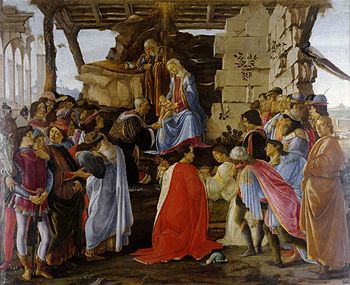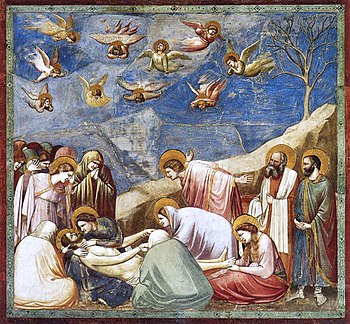Introduction
The theme under analysis is “Examining the Humanities,” and two visual artifacts below represent it.
Main body

The first visual artifact is called The Adoration of the Magi. Sandro Botticelli, an Italian artist, painted it from 1475 to 1476 (Virtual Uffizi Gallery, n.d.). It is now displayed at the Uffizi, Florence, and is considered among the best paintings depicting the Medici family members in the role of the Magi and the Virgin. The visual artifact demonstrates the scene when the Virgin shows a baby, Jesus Christ, and numerous people, including the Magi, adore the son of God. It is possible to suppose that the artwork is familiar for all the Christians around the world because it displays a Biblical event.

The second artwork, The Lamentation, also depicts a biblical plot. It was created by Giotto di Bondone, a Renaissance artist, approximately in 1305, and one can currently find this masterpiece on one of the interior walls of the Scrovegni Chapel in Padua, Italy (The History of Art, 2021). The fresco depicts the scene when Jesus was killed and his body was removed from the cross. Apart from Jesus, the artifact displays the Virgin, Mary Magdalene, John the Apostle, and others. All these people surround the dead son of God and are sorrowful in the same manner as the angels in the sky are. This fact represents a close connection between humanity and Heaven.
As has already been mentioned, the “Examining the Humanities” theme is under consideration because it relates to the two artifacts. It is possible to say that the selected artworks demonstrate the process of human life because the first painting depicts the birth of Jesus, and the second one shows his death. Even though diversity is a topical issue today, and people are respected for having different customs, traditions, nationalities, and others, some features are still universal for all humans. One of them refers to the transience of being, and no person can escape the final outcome that is the tomb. It seems that the two artifacts reflect this topic because they tell the story of Jesus Christ. I can also suggest that the theme comments on the connection between people and God. The two artifacts depict biblical plots, denoting that religion occupies an essential place in human life. In addition to that, these two artworks show saints alongside ordinary individuals. This fact can also demonstrate that spirituality affects everyday life, and people should draw some attention to this field.
Conclusion
In conclusion, I can say that the discovered theme is essential personally for me. Even though I cannot say that I am an entirely religious person, the plots are familiar for me because I am aware of the basics of Christianity. Furthermore, religion still occupies a significant role for me, and I frequently think about how impermanent people’s lives are. Such negative thoughts are incredibly vivid when some tragic events, catastrophes, or casualties occur. However, it is necessary to understand that the theme and the two cultural artifacts do not teach us to be pessimistic or be in a constant state of fear. Instead of it, the identified topic can be interpreted as a sign to live a full life and value every moment. However, it is also necessary to remember a spiritual aspect of the world, which should make individuals behave diligently and adequately.
References
The History of Art. (2021). Lamentation (The Mourning of Christ). Web.
Virtual Uffizi Gallery. (n.d.). The Adoration of the Magi by Botticelli: An artwork full of innovation. Web.